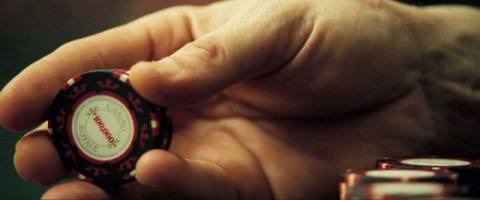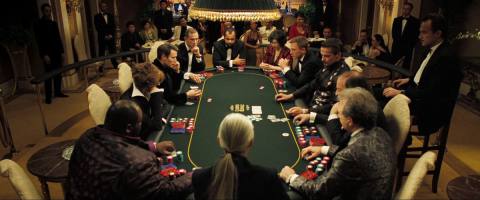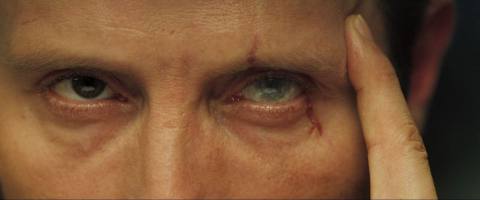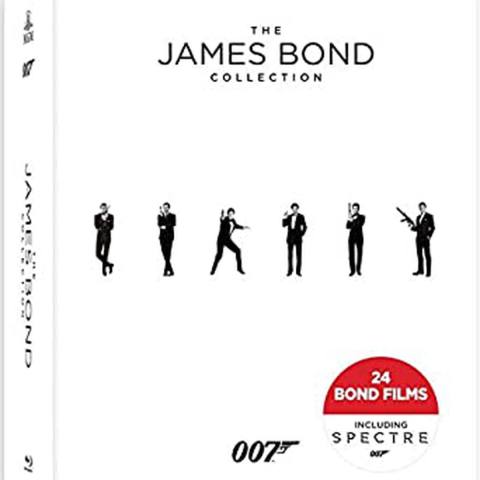The script for Casino Royale worried director Martin Campbell. This was his second reboot of the James Bond franchise, and on the cusp of production, he realized the movie’s centerpiece — a showdown between 007 and the blood-eyed villain Le Chiffre — took place around a quiet poker table. Loosely adapting Ian Fleming’s 1953 novel of the same name, screenwriters Neal Purvis, Robert Wade, and Paul Haggis had replaced the author’s original game of baccarat with three big rounds of Texas hold’em. The card game, they believed, made for better drama — it was known more widely, required more skill and delivered higher stakes. But for Campbell, who had never picked up a deck, it looked like a snooze.
“There was a lot of [card] playing in it,” he tells Polygon. “It was the thing I sweated on more than anything else.”
In 1995, Campbell introduced Pierce Brosnan as Bond with Goldeneye, which moved on from Timothy Dalton’s gritty take into a more fantastical realm. Over the next three movies, the stories became excessively kitschy. By the time Brosnan finished 2002’s Die Another Day, driving invisible cars through ice palaces, Bond producers knew the franchise had shifted into self-parody. “They wanted to bring it back to earth,” Campbell says. “When I came on board, I felt the same way. I felt the whole thing needed to have its feet well and truly on the ground.”
That meant a contemporary action movie — tougher, grimmer, less reliant on CGI, and more devoted to realism. When Daniel Craig signed on to embody the new direction, he embraced the idea of portraying a vulnerable hero. His Bond was brazen, reckless, emotionally-charged. He made mistakes, but looked good (if occasionally bruised) making them. It was the perfect kind of character to get involved in a high-tension poker game. Still, Campbell thought, how would he animate this green-felted drama?
“It was difficult to think how you keep the audience engaged in those card games,” the movie’s editor Stuart Baird says. “Everybody was terribly worried that people would be bored with it.”
Campbell cracked it. The roughly 30-minute casino sequence plays as a masterful microcosm of the movie — it has its own narrative arc, interspersed with punctuations of combat and death-defying shocks, and shows off Bond’s mental prowess and mortality. More importantly, it proved Craig capable of daredevil thrills and martini-sipping refinement, and leveraged his skills into one of the best depictions of poker in movie history. “I think the sequence was pretty convincing,” Campbell says. “What you realize is, it’s not just the card games — it’s the stakes. It’s also two guys eye-fucking one another, basically. That was the secret.”
Pulling it off, however, took weeks of research, tight editing and, crucially, a devotion to poker authenticity.

Before he began shooting Casino Royale in Prague, Campbell devoured gambling classics like The Cincinnati Kid and 5 Card Stud. He had to understand the game on a molecular level and leaned on veteran producer Michael G. Wilson, who also served as an informal poker consultant, to teach him the ins and outs.
Then there was the tactical filming strategy. Baird, who had edited Richard Donner’s 1994 western comedy Maverick, had a few tips. While on that movie’s set, Baird remembered the way Donner had chosen to shoot Mel Gibson and how he built tension for the movie’s climactic scene. “He said shoot everything you can possibly think of, especially eyes, looks, close-ups,” Baird recalls. “I told Martin to do the same: just shoot the hell out of everything that you possibly can.”
Baird’s suggestion fit Campbell’s action-oriented background seamlessly. In one of the movie’s propulsive opening scenes, Bond chases a bomb-maker throughout a construction site in Madagascar. It’s a mesmerizing parkour pursuit, and Campbell captures the pair’s daredevilish, aerial gymnastics from every angle. “He’s a bull in the china shop,” Campbell says of Bond. “He just hurls himself no matter what the dangers are, he’s not really thinking.” The kinetic filmmaking — the quick cutting and numerous perspectives — along with 007’s impulsive style gave the director a blueprint for bringing the staid poker scenes to similar life.
To achieve the subtleties of the game, the production enlisted Tom Sambrook as a formal poker consultant. While at drama school in his 20s, he’d started playing poker religiously, eventually becoming a professional at the Victoria Casino in London. In 2002, he won the European Poker Championship, and over the next three years, as the game migrated online, Sambrook made a living beating novices on the internet. Then, in 2005, a brief came through his actors’ agency asking for someone to help direct a poker tournament in Europe. “It wasn’t really clear what it was,” Sambrook says. “I went up for it, and only then, when they shipped me out to Prague, where I met Michael Wilson, did I realize it was a Bond gig.”

As Campbell and his crew built and prepared their makeshift casino, a set that would give the director space to put the camera anywhere he’d like, Sambrook began training multiple actors (some for the main tournament, others for the movie’s earlier games) to transform them into legit-looking players. He set up small tables and played multiple hands, instructing throughout the process. “I would get them for 15-20 minutes in a room in a basement at Barrandov [Studios], where they’d set up a poker table,” he says. “I’d just basically tell them what the absolute bare minimum was that they needed to know to look like they had been playing this game.”
Fundamentally, Sambrook explains, veteran poker players operate with an absolute economy — they handle their cards, stack their chips and move their eyes in small, efficient manners. With such a big pot on the line, displaying those subtle virtues was critical. “There’s none of these grand movements, nothing extravagant,” Sambrook says. “It looks weird if you arrive at the poker table with loads of attitude but not much going on behind it.” He impressed upon actors to lose clichés and replace them with a genuine decision-making process. He lectured them about the aerodynamics of tossing chips and the importance of keeping cards flat on the table. Effectively, all the “stuff that sticks out like a sore thumb if you don’t [play a lot],” he says.
To get the crew involved, Wilson also staked a friendly game during the production’s off-hours to teach the rules and regulations. Some cast members even went to casinos in Prague to watch the natural flow of professionals. “I’m a Scotch Presbyterian — I hate gambling,” Baird admits. “I think Daniel Craig won [our game]. I lost after about 15 minutes.” Adding another layer of authenticity to the movie, Campbell cast Andreas Daniel, an Austrian casino inspector who “could do all the tricks,” to be the movie’s official dealer. “I really was lucky,” Daniel says. “My experience as a dealer helped a lot.”
By the time shooting began in Karlovy Vary, the cast — including Mads Mikkelsen and Jeffrey Wright — had become addicted to poker. “We’d be playing games constantly between takes,” Sambrook laughs. “It got confusing, because I’d been trying to deal three or four different games with different people in it, and keep track of their stacks, and I’m trying to remember whose stack is whose.” Though Sambrook had taught Mikkelsen to twirl chips around his finger and look like a professional, the Danish actor and his peers couldn’t hide their amateurish skills. “They’re paid good per diems,” Sambrook says. “I saw it as their privilege to learn by paying me this money.”
The aesthetic goal, of course, had been achieved. For the next nine days, Campbell had a cast of professional-looking poker players — not to mention dealers, bankers and observers — at his disposal. “I thought they were very convincing,” Campbell says, before acknowledging the challenge of shooting it all. “It was [going to be] a mathematical exercise.”

Although Casino Royale set up shop in Prague, the actual poker sequence occurs at a Montenegro hotel. Inside, Bond has been staked by MI6 to play in an international hold’em-style poker game hosted by Mikkelsen’s LeChiffre. The movie’s villain hopes the 10-person, $130 million game will recoup his recent financial losses and appease his angry clients, believed to be global terrorists. Though Bond’s participation means potentially funding criminals, he’s Britain’s best shot to bankrupt LeChiffre and end his underground transactions.
Ultimately, only three hands matter in Casino Royale, and they all feature showdowns between Bond and LeChiffre, providing a three-act structure to the heart of the movie. The first watches Bond muck his cards and intentionally lose to discover LeChiffre’s tell; the second watches LeChiffre dupe Bond and eliminate him from the table with quad jacks; and the third watches Bond return to the tournament to redeem himself with a straight flush. In between, Bond spends a drink break by suffocating two assassins in a stairwell and, at a later intermission, survives a poisoned drink after Vesper (Eva Green), his British accomplice, defibrillates him with his life hanging in the balance.
“This is sort of Bond before he becomes Bond, thinking with his heart instead of his head,” Campbell says. “From a dramatic point of view, each of the card games has a good climax […] The point was you would never play it as one long, single game … I think it would have tested the audience’s patience.”
To capture the intensity of each hand, Campbell followed Baird’s early advice. He and his assistant director mapped out camera placements hours before action was called, eventually grabbing numerous angles and reactions in master shots and close-ups. “You’re changing the variety so you maintain the interest from an audience point of view,” Baird says. Campbell also had to be aware of continuity, and used crew members to fill in for players between takes so he could determine his next shot. “When I called cut, you would have to go back to a certain point, and everybody’s chips had to be put back, all the cards had to be relayed,” he says. With so many players and cross-cuts, he made it a priority to establish the geography of the table. “It’s a film-school exercise to put 10 people around a table all looking at one another, giving a lesson in eye-lines and the way they’re reacting to one another. You just slog through it.”
Baird watched the dailies on set and cut together the scenes in real time, making sure the poker kept a swift rhythm. As a way to narrate and explain the game, Mathis (Giancarlo Giannini), Bond’s contact, watches with Vesper from afar and explains the hands, the odds and the motivations of each player. For those unfamiliar with the game and the implications of a bet, check or call, his commentary became a useful guide. “You have to get shots of observers watching them, particularly Vesper and Mathis,” says Campbell, applauding Baird’s economic choices. “You really have to have the material to be able to control the pace of the edit.”
From the script alone, Sambrook knew that Purvis, Wade and Haggis had “clearly played poker” and that the cards built the drama effectively. But the characters’ betting strategy, specifically when LeChiffre eliminates Bond from the table, had flaws. In the original script, Bond moves all-in once he sees LeChiffre’s tell. In actuality, Sambrook recognized, Bond would have teased his opponent until the last bet, trying to coax more chips, if he really thought he was bluffing. “That had to change,” Sambrook says. “I put in [the script] that Bond does the teaser re-raise, inducing the big all-in. It took maybe six weeks to get that up to Martin Campbell […] I said, ‘You’ve got to read this,’ because most people won’t know or care, but there will be hardcore poker players that will just say, ‘They’ve done it again. Why can’t they get this stuff right?’”
In the game’s final hand, four competitors remain. After numerous checks around the table, the dealer places down a river card, providing a variety of flush and full-house opportunities. Two opponents go all-in, and after a long stare-down with LeChiffre, “the Mexican standoff,” Campbell suggests, Bond risks his entire chip pile, too. The villain has the best full-house combination, and takes a chance on his odds, pushing his stack into the middle of the table. After each player reveals his cards, Bond pauses dramatically and then flips over a five and seven of spades, completing an unlikely straight flush and winning the tournament.
The victory is emblematic of the new Bond — he’s not flashy or obvious. “He wins with an inconspicuous straight flush, rather than the royal flush,” Sambrook says. Over the nearly 15 years since the movie’s release, the improbability of each player’s decision to risk everything has been debated over Reddit and by other poker players. But Sambrook, who advised Campbell on the sequencing of bets and bluffs, stands by the improbable scenario as a highly enjoyable cinematic pay-off.
“It’s not representative of an average hand. But the thing about hold’em is it does create these factories of madness,” the poker consultant says. “That’s why I love the game. It creates this very close, explosive situation. Once you’ve got a board with cards that close together, everyone’s thinking about the house, everyone’s thinking about the flush, everyone’s thinking about the straight. And in there is the sick feeling, Christ, does one of these guys have a straight flush?”
Campbell does concede one error at the end of the sequence. Before Bond leaves the table, he slides a plastic chip worth $500,000 over to the dealer as a courtesy tip. It’s a seemingly nice gesture, but the chip isn’t worth anything outside the game’s context. “I always laugh at the end when Bond just flips him half a million,” Campbell says. “It was just amusing to me — it’s not Bond’s money.”

Midway through shooting the poker sequence, Campbell knocked out the game room’s wall and wheeled in a crane. Unsure if he needed to convey big sweeping transitions into the movie to indicate the passage of time, the director set up a time-lapse camera above the table. But after looking at the footage, Baird knew it would eliminate the movie’s spark. “It would have been really boring if we had done all those dissolves,” he says. “That’s not interesting.”
The director agreed, instead relying on his most valuable asset to carry the audience to its high-rolling finale: The witty banter, volatile interruptions, and contemplative pauses of Daniel Craig. Initially second-guessed and criticized by dubious Bond fans when he signed onto the production, Craig redefined the role by exposing its humanity. On the brink of death multiple times, he wears his bruises and blood stains like a badge of honor, and then dispenses his brutality at the table, sliding into a smooth-talking, card-playing competitor to match Mikkelsen’s commanding presence.
It’s a complex transition required for such an impenetrable, legendary character, and Craig showcases his deft ability, quite literally, in spades. “He looked like a guy who had been in the special forces rather than the commander of a boat,” Baird says. “And that ruggedness, that sense of edginess, and lack of comfort — he carried them off very well.”
As a consequence, the game itself — its authenticity and attention to detail — instantly elevated Casino Royale into poker movie canon. Though primarily an action director, Campbell treated the material with a seriousness and sophistication that set the tone for the rest of the Craig era. He made poker accessible and, in effect, riveting, helping the movie earn $606 million at the global box office. “I think it’s a combination of everything,” Campbell says. “We achieved what we set out to do, which was reboot the franchise into a much more contemporary, more realistic way.”
As Sambrook can attest, the movie’s 2006 release also capitalized on poker’s soaring, televised popularity at the time. It didn’t take long for experts to saturate online games, a consequence that pushed him back into academics. Still, he’ll always be appreciative of his experience playing with Craig and Mikkelsen and making extra scratch from his other temporary apprentices — one of whom, the British actor Ade, shared his flight home, eager to keep his rare poker experience alive just a little longer.
“I played my last game literally as the wheels of the plane hit the tarmac in Heathrow,” Sambrook says. “I won with King-high, it was just fantastic.”
Casino Royale is currently streaming on Netflix, Amazon Prime Video, and Hulu
Vox Media has affiliate partnerships. These do not influence editorial content, though Vox Media may earn commissions for products purchased via affiliate links. For more information, see our ethics policy.

